New Mexico is a large state in the southwestern region of the United States. It is an incredibly diverse state and has vast deserts and stunning mountains, as well as grasslands and forests. Animals thrive in New Mexico as it is such as large, diverse state. Particularly abundant in the state are snakes – there are 46 different species, of which eight are venomous. If you’re out exploring then you’ll need to know how to identify the snakes you come across. Here’s a picture graph to help with that:
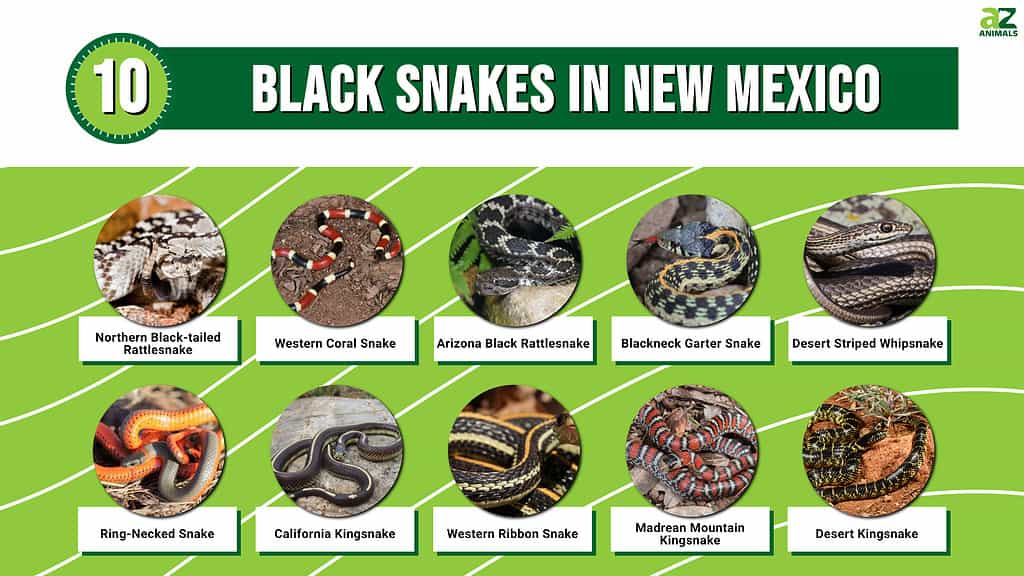
So join us as we learn about the black snakes in New Mexico – including which ones to avoid!
1. Northern Black-tailed Rattlesnake (Crotalus molossus)
We’ll begin our list with the first of three venomous snakes – the northern black-tailed rattlesnake which is a subspecies of the black-tailed rattlesnake. These snakes usually reach no more than 48 inches long and are grey or brown with large dark brown or black blotches. However, the most distinguishable feature of these snakes is their entirely black tail. Northern black-tailed rattlesnakes range across Arizona, New Mexico, southwest Texas, and Mexico. They live mainly in the south-western region of New Mexico where they can be found in the mountains and low desert regions at elevations up to 8,000 feet. Their venom is hemotoxic, but they are not usually dangerous to humans due to their fairly docile nature.
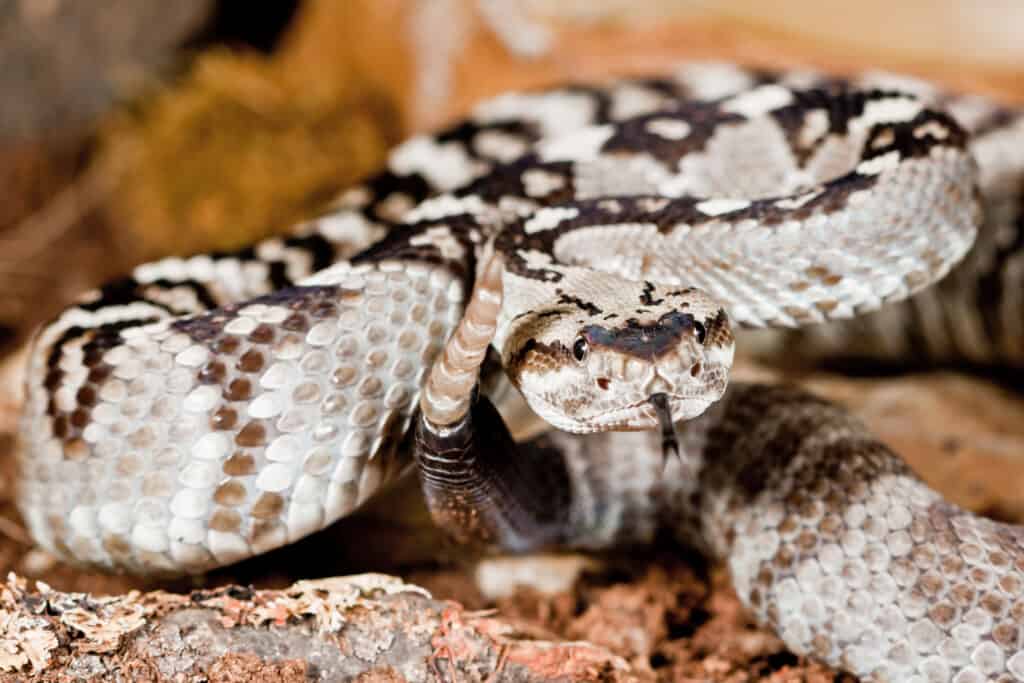
Northern black-tailed rattlesnake though docile in nature is a venomous snake, most easily identified by its black tail.
©iStock.com/pitchwayz
2. Western Coral Snake (Micruroides euryxanthus)
A snake with a very distinctive appearance is the western coral snake which is also known as the Arizona or Sonoran coral snake. These snakes are small – reaching only 13 to 24 inches – but have striking black, red, and yellow or cream bands and an entirely black head. Western coral snakes are dangerous and contain a powerful neurotoxic venom, although they only have small fangs and a fairly ineffective system of injecting it. Western coral snakes are endemic to northwest Mexico and the southwestern region of the US. They are only found in the southwestern region of New Mexico – in southwest Catron, western Hidalgo, and western Grant counties. They inhabit rocky areas on lower mountain slopes, plains, and dry river bottoms. However, they are not found above 5,900 feet.

Western coral snakes have a powerful neurotoxic venom and are easily identified by its alternating black, red, and cream bands along its body.
©Nathan A Shepard/Shutterstock.com
3. Arizona Black Rattlesnake (Crotalus cerberus)
Another black snake in New Mexico is the Arizona black rattlesnake. These snakes reach up to 42 inches long and are dark gray to black with black blotches. Arizona black rattlesnakes are only found in Catron and Grant counties at elevations between 6,100 and 8,000 feet, as well as at Steeple Rock. They prefer to live in grasslands and woodlands and on rocky slopes. They are mainly diurnal and prey on a range of small mammals, birds, amphibians, and other reptiles. Their venom is neurotoxic and can potentially be lethal.
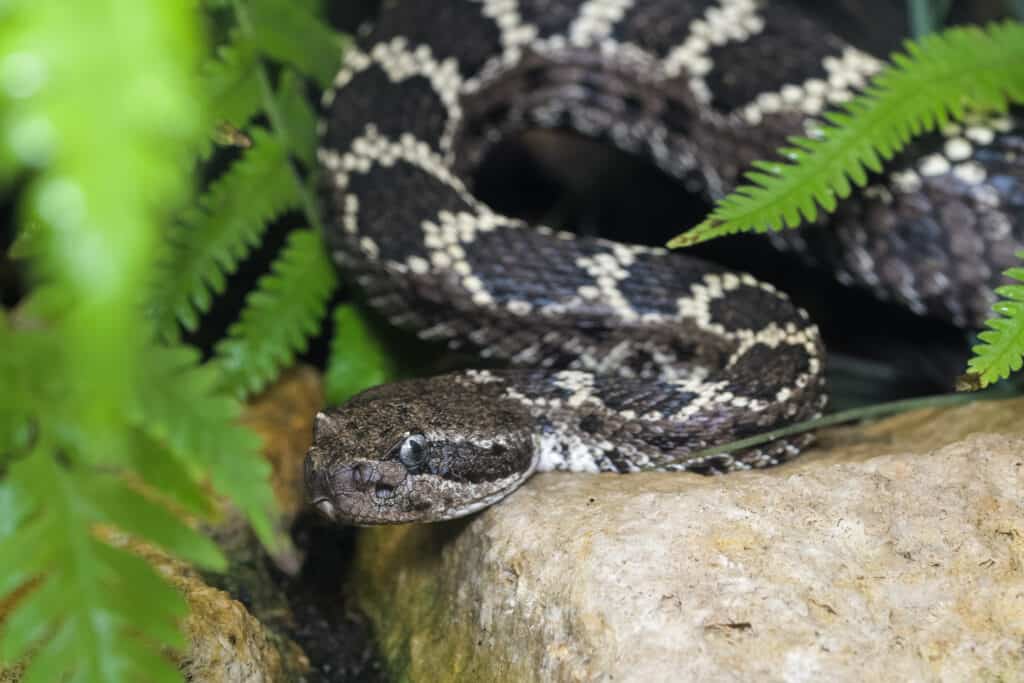
The Arizona black rattlesnake can reach up to 42 inches in length and have a venom that can be lethal.
©iStock.com/Thorsten Spoerlein
4. Blackneck Garter Snake (Thamnophis cyrtopsis)
One of the most common snakes in New Mexico is the blackneck garter snake which is found across the majority of the state, with the exception of the southeastern border. Blackneck garter snakes are 16 to 46 inches long and are gray with yellowish orange stripes and rows of black or brown spots. They also have large black blotches at the back of their neck. Blackneck garter snakes live in and around streams on mountains and in grasslands and woodlands. Although they are not considered to be venomous to humans, these snakes are mildly venomous to their prey which consists of small fish, amphibians, and earthworms.
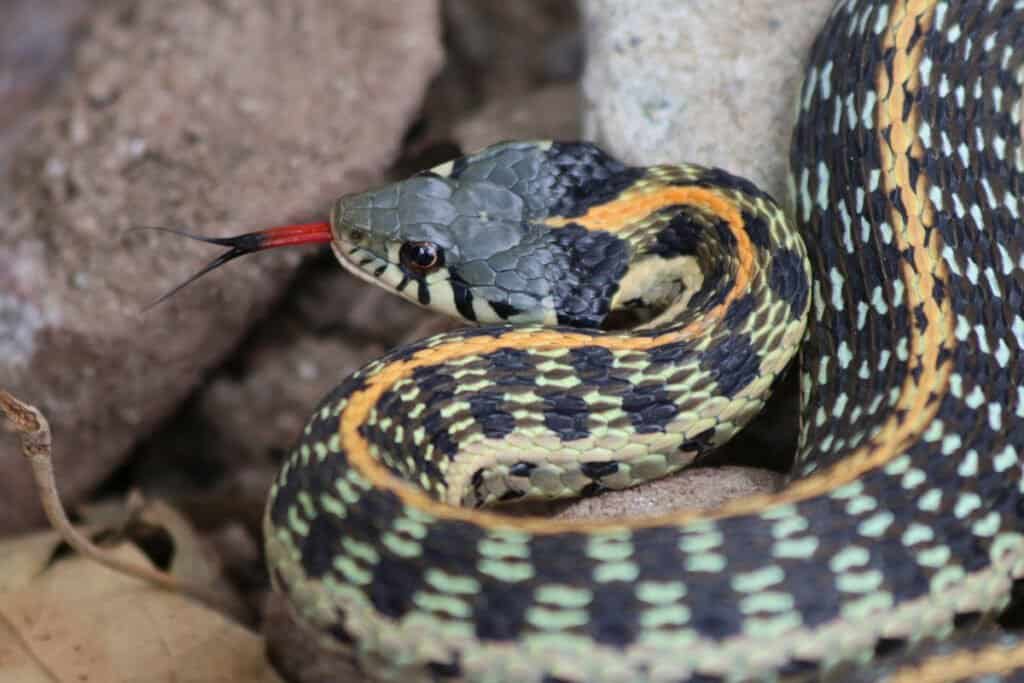
Blackneck garter snakes are common in New Mexico and are gray with yellowish orange stripes with rows of black or brown spots.
©Creeping Things/Shutterstock.com
5. Desert Striped Whipsnake (Coluber taeniatus)
The desert striped whipsnake is a subspecies of the striped whipsnake and is again fairly common throughout New Mexico. They are around 65 inches long and have brown, gray, or black bodies with yellow or cream stripes. Desert striped whipsnakes inhabit woodlands, grasslands, plains, and canyons everywhere across the state, with the exception of the counties along the southern and eastern borders. They are quick-moving, diurnal snakes which can often be seen searching for prey with their head raised up off the ground.
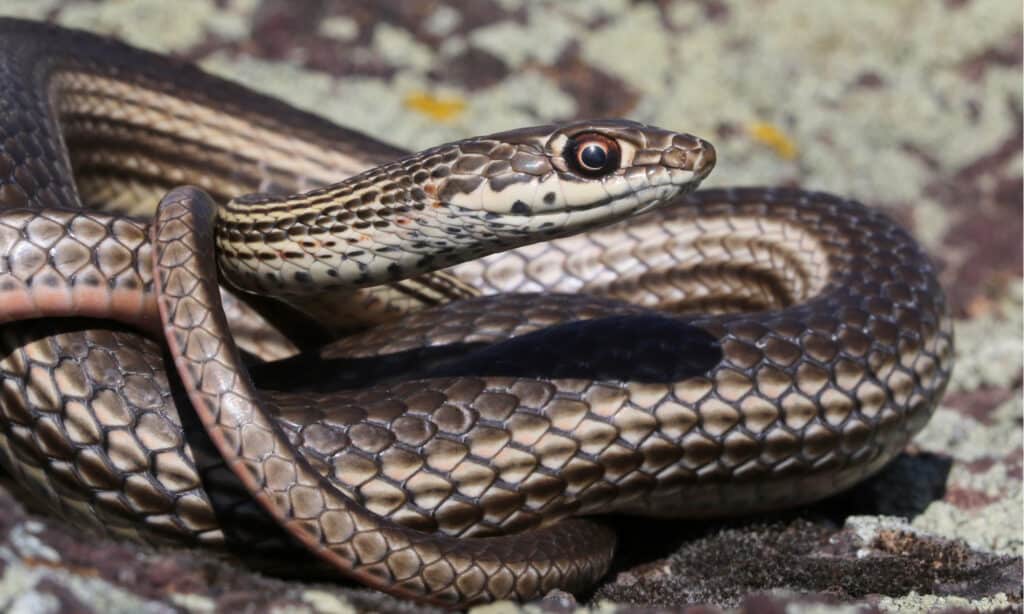
Desert striped whipsnakes inhabit woodlands, grasslands, plains, and canyons across New Mexico.
©Randy Bjorklund/Shutterstock.com
6. Ring-Necked Snake (Diadophis punctatus)
The smallest black snake in New Mexico is the ring-necked snake which only reaches 10 to 20 inches long. These snakes are usually black with a bright ring of color around their neck – either red, orange, or yellow. However, sometimes their belly can be the same color as their neck ring. They are nocturnal as well as being shy and secretive. This means it is unlikely that you will see these fascinating little snakes. There are two subspecies present in New Mexico – the regal ringneck and the prairie ringneck. Between the two of them, ring-necked snakes are found across the majority of the state (although not the northernmost regions) in forests and woodlands – with regal ringnecks inhabiting the eastern half and prairie ringnecks inhabiting the western half.
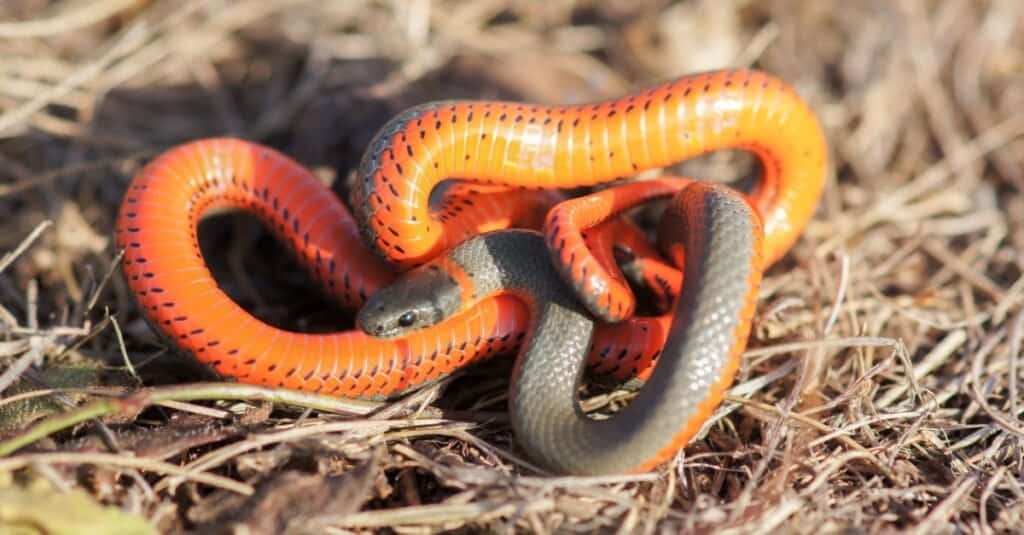
The brightly colored ring-necked snake is nocturnal, shy and non-venomous.
©yhelfman/Shutterstock.com
7. California Kingsnake (Lampropeltis californiae)
Another stunning black snake in New Mexico is the California kingsnake which has distinctive black and white banded markings. They are large snakes and usually range between 24 and 51 inches long, although larger specimens are not completely uncommon. California kingsnakes have a very limited range in New Mexico, living only in the far northwest corner of the state – along the San Juan River in San Juan County and usually within no more than five miles of the Arizona border. They are not venomous but prey on several other species of snakes – including rattlesnakes.
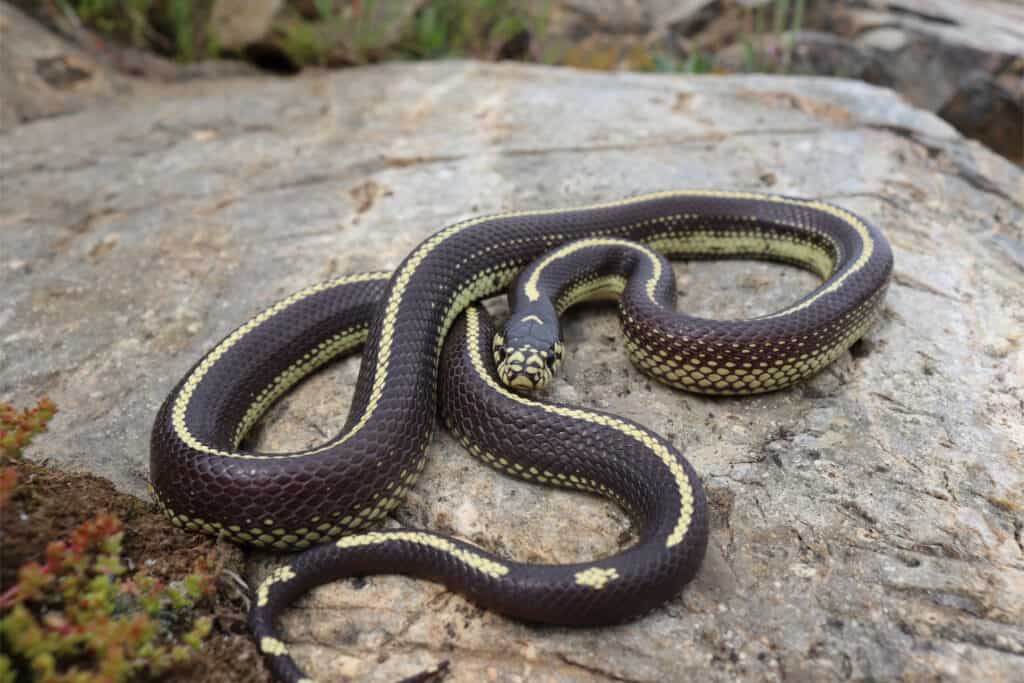
The California kingsnake is not venomous but preys on several other species of snakes in New Mexico including rattlesnakes.
©Creeping Things/Shutterstock.com
8. Western Ribbon Snake (Thamnophis proximus)
A protected snake in New Mexico is the western ribbon snake. These snakes are only found in limited locations in the northeast and southeastern regions of the state. Although they can live in a variety of habitats, they are most often found near permanent water sources such as ponds, lakes, and marshes. Western ribbon snakes are 18 to 48 inches long and have black or brown bodies with three lighter-colored (yellow, orange, or tan) stripes. They are not venomous to humans; however, they do produce a substance that resembles venom in their Durvenoy gland which is venomous to their prey. They lack traditional fangs and employ this venom through a chewing action.
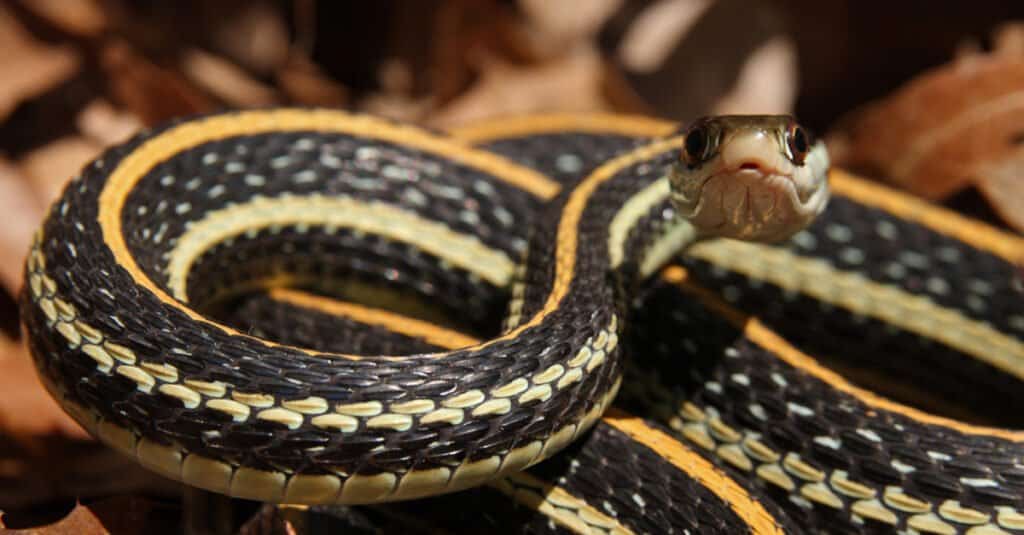
The Western ribbon snake is most often found near permanent water sources such as ponds, lakes, and marshes.
©Ryan M. Bolton/Shutterstock.com
9. Madrean Mountain Kingsnake (Lampropeltis knoblochi)
The Madrean mountain kingsnake has a very small range in New Mexico. It is only found in the far northwest of the state where they inhabit rocky talus slopes near streams in forests at elevations between 3,000 and 9,000 feet. They are 30 to 48 inches long and have a similar appearance to the coral snake – with bands of red, black, and white. Although they are diurnal snakes, they are very secretive, and this – combined with their small range – means that you are unlikely to ever see one in the state. They are not venomous and eat lizards, amphibians, and rodents.
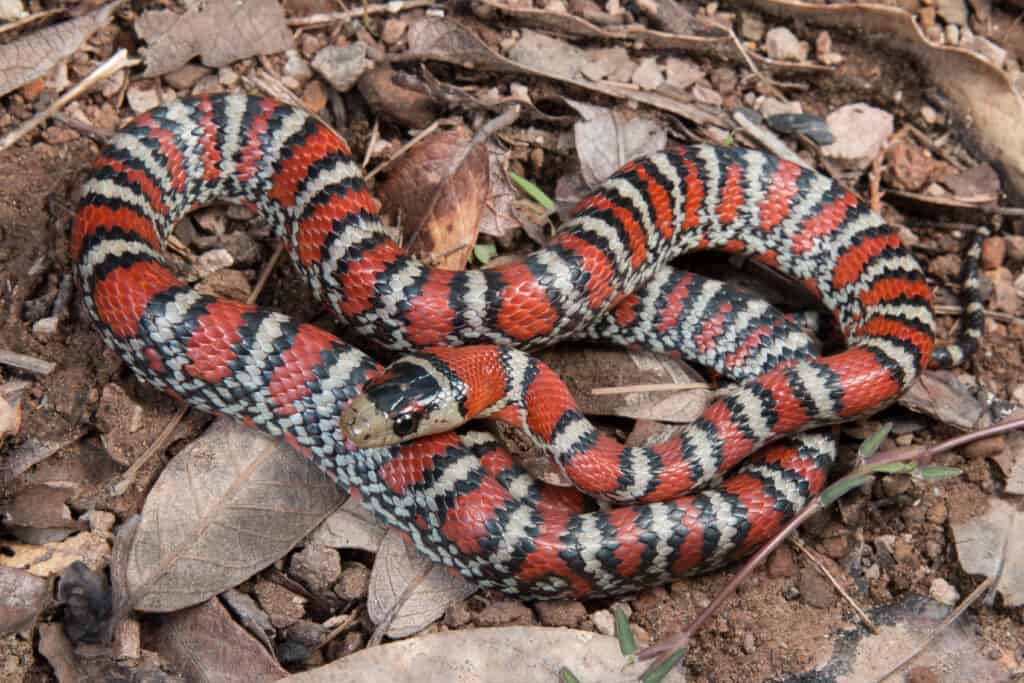
Madrean mountain kingsnakes are 30 to 48 inches long and have bands of red, black, and white.
©Nathan A Shepard/Shutterstock.com
10. Desert Kingsnake (Lampropeltis splendida)
The final black snake in New Mexico is the desert kingsnake. They are 24 to 36 inches long and are black with thin yellow crossbands across their back and either yellow or white speckles. Desert kingsnakes are fairly widespread across the state. They can be found in most counties, with the exception of those in the far north and northwest. They live in a wide variety of habitats – including grasslands, woodlands, prairies, and deserts. Like other kingsnakes, they are not venomous, but are beneficial predators of other, more harmful snakes.

Desert kingsnakes can be found across New Mexico and are easily identified by their distinct black bodies with yellow markings.
©Jon Bolton/Shutterstock.com
Summary of 10 Black Snakes in New Mexico
| Name | Length in inches | Habitat |
|---|---|---|
| Northern Black-tailed Rattlesnake | Up to 48 | Mountains and low desert regions up to 8,000 feet. |
| Western Coral Snake | 13-21 | Rocky areas on lower mountain slopes, plains, and dry river bottoms below 5900 feet. |
| Arizona Black Rattlesnake | Up to 42 | Grasslands, woodlands and rocky slopes. |
| Blackneck Garter Snake | 16-46 | In and around streams on mountains and in grasslands and woodlands. |
| Desert Striped Whipsnake | 65 | Woodlands, grasslands, plains, and canyons. |
| Ring-necked Snake | 10-20 | Forests and woodlands. |
| California Kingsnake | 24-51 | Along the San Juan River in northwest New Mexico. |
| Western Ribbon Snake | 18-48 | Near water sources such as ponds, lakes, and marshes. |
| Madrean Mountain Kingsnake | 30-48 | Rocky talus slopes near streams in forests at 3,000-9,000 feet. |
| Desert Kingsnake | 24-46 | Grasslands, woodlands, prairies, and deserts. |
The photo featured at the top of this post is © jokerbethyname/Shutterstock.com
Discover the "Monster" Snake 5X Bigger than an Anaconda
Every day A-Z Animals sends out some of the most incredible facts in the world from our free newsletter. Want to discover the 10 most beautiful snakes in the world, a "snake island" where you're never more than 3 feet from danger, or a "monster" snake 5X larger than an anaconda? Then sign up right now and you'll start receiving our daily newsletter absolutely free.
Sources
- New Mexico Department of Game and Fish, Available here: https://www.wildlife.state.nm.us/download/education/conservation/wildlife-notes/amphibians-reptiles/Sonoran-western-coral-snake.pdf
- New Mexico Herpetological Society, Available here: http://nmherpsociety.org/reptiles/snakes/crotalusmolossusmolossus/index.html
- New Mexico Herpetological Society, Available here: http://nmherpsociety.org/reptiles/snakes/colubertaeniatustaeniatus/index.html
Thank you for reading! Have some feedback for us? Contact the AZ Animals editorial team.






